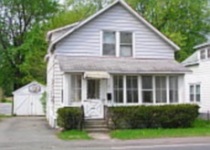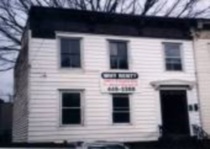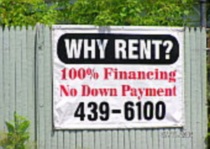moneynews Friday, 29 Jun 2012
Yale’s Shiller to Moneynews: Home Prices Could Plunge Even Lower
Home prices have risen lately but nothing suggests that a concrete recovery for the sector is taking place, and prices could fall even lower, Yale economist and author Robert Shiller said.
“I think it’s a good chance that home prices may fall still further,” Shiller told Newsmax.TV in an exclusive interview.
He also is co-creator of the S&P/Case-Shiller Home Price Indices, the widely followed measure of U.S. home prices. The measure revealed in April that on average home prices increased 1.3 percent from March for both 10-city and 20-city composites.
The gain came after seven consecutive months of falling home prices as measured by both indices. Home prices tend to rise in the summer,… But he still warns that prices may dip yet again.
“Things are looking up, and this could be the turning point, but it is way too early to tell and the weakness of the economy and the coming foreclosures and the European crisis are all risks that are very much relevant on the horizon for real estate,”…”We are kind of still in unchartered territory. So I don’t think there is any expert who can tell you what is coming with housing. It continues to surprise,” said Shiller
“I don’t have any confidence in my ability to forecast them [future housing sales] but what I do feel confident about is there remain uncertainties and risks. Housing is still not a riskless investment. We shouldn’t be thinking that we are sure that we are at a bottom. We are not sure.”
Read more: Yale’s Shiller to Moneynews: Home Prices Could Plunge Even Lower
********************
Coach Mitch’s REFLECTIONS™
Fair Market Value
All economic research and therefore, all answers to economic questions are based on situations rated at the current FMV, Fair Market Value.
Factory orders, agricultural products, services, construction, real estate, etc. are all calculated at their Fair Market Value, and that is the way it should be, for economists like Shiller.
However, you and I don’t operate in the same rarefied air that economists breathe. You and I are more down to earth. When we buy something, we look for sales, we look for value, and we look to make deals. Shiller is looking at macro-economic data and making estimates and coming to conclusions for our entire society and world. But, I’ll bet that when he’s looking for a car for himself that he is not paying MSRP, Manufacturers Suggested Retail Price. Only fools and our government pays full price.
Buying at Retail vs. Wholesale vs Fire sale
Products are purchased at three distinct price points. Let’s call them Retail, Wholesale and Fire sale!
When we buy at regular price, we are paying retail. When we buy something “on sale” or from a distributor or from a reseller like Overstock, we are paying closer to wholesale. When we stumble upon or set out to find a unique “don’t-wanter” situation, then we have the potential to buy at fire sale.
Certain businesses specialize in finding “closeout” inventory of all sorts. They buy at fire sale so they can sell to you at wholesale. When a firm goes out of business, competitor’s line up to buy that inventory at prices less than they would normally pay. These are full buy out situations, not onesie’s or twosie’s. Bankruptcy buyout companies come to the table with big wads of cash and bid to purchase entire inventories from factories or outlets desperate to unload bulk merchandise.
Real estate – retail
The same principle works in real estate. Realtors work at retail. Listing and selling at retail is the way realtors are taught; that is all they are comfortable with, and that is why realtors do not usually work well with investors, unless the investors are willing to pay retail, which many do. To a realtor, a “good deal” is 10% off the listing price.
A typical REI “good deal”
I recently spoke with a newbie investor who had just gotten a two family, at 10% off list price. He said he had paid $180k and was very proud. I went through the numbers with him. He was happy to say that his apartment only cost him $600 per month. He was less happy when I showed that he would be in deep trouble unless the 2nd apartment was continually rented and that the tenant actually paid the rent – because he could not afford to pay the additional $1200 per month towards the mortgage if the rent were late or if the apartment were to be vacant for even one month.
Newbie investors only look at the bright side. One of the real issues is that Realtors are taught to only define the property expenses as PITI, Principle, Interest, Taxes and Insurance. Realtors do not include the full complement of property expenses that you will find on an APOD statement, Annual Property Operating Data. I think it is bordering on unethical behavior to not utilize an APOD statement when selling an income property, including a single family meant for rental.
To correctly capture all expenses, Coach Mitch offers “The Formula” which is an APOD statement on steroids along, with a sales program showing the seller the high number of expenses that the property needs to pay, and therefore justifying why the price must come down. “The Formula” comes complete with the form, detailed explanation and sales scripts. It works!
Real estate – wholesale
There are many opportunities to buy real estate at wholesale, which I would put at 65% of retail. Hard money lenders typically will not lend above 65% ITV, Investment To Value. Properties needing substantial rehab can often be negotiated down to below the 65% level. This is important because construction estimates are always well under budgeted, so you had better leave a lot of room.
When buying real estate at wholesale there is the very real potential of making a significant profit, especially at the higher prices; e.g. an After Repaired Value of $400K requires a purchase price of no more than $260K. This allows for a rehab of no higher than $90K, including mistakes and at least a $50k pretax profit.
The above formula is being taught by most guru’s, i.e. ARV $400K x 65% = $260K max purchase. Having done my share of rehabs, I believe 65% is much too high to pay. I’ve never paid more than 50% of market value for an investment property.
You can see a good example of this by reading the story of this deal.
Real estate – fire sale
The Stories of Deals, one above, are good examples of the fire sale prices that are possible when finding a unique situation – and then handling the situation correctly. (this is the important part)
Individual bank foreclosures are typically NOT sold at fire sale prices. Banks want as much as they can get and have a strong interest in keeping prices high. Mortgage insurance typically pays for the first 20% lost in foreclosure, so banks often ask for 80% of FMV.
Bulk foreclosure sales
If you have access to large amounts of money, often millions are needed, then you can bid against others with large amounts of money and try to buy tranches of foreclosures, often in lots of a minimum of 100 properties. Sometimes the lots are in the thousands of properties. These can be gotten at fire sale prices.
Should you have this kind of capital you can then sell at wholesale for a good profit, or, if you don’t have millions, you can try to find the bulk wholesale buyers and pay them wholesale for a single property. Be warned, the properties purchased in bulk are often the worst of the worst that the bank had owned.
The bulk REO properties will often need very substantial rehab, will be in the bad part of town, or they will have a very short time until the county will take them for nonpayment of taxes. Read about the “Burnout”, because it is a good example of a property that I optioned from a bulk REO buyer. Be very, very careful if buying from a bulk REO seller. I looked at several properties that he had and one was worse than the next. I chose the “Burnout” because it was in a good area and the contractor who lived next door wanted to buy it.
Fire sale means high profits
A little while ago I blogged about a student who had paid $20K for a property that was worth $180K ARV. What if the young man above with the 2 family had searched for a similar situation? Instead of an $1800 monthly PITI he might not have any mortgage. That is safety.
The only reason people sell at fire sale prices is that they have no other choice. Everyone wants the most they can get. These particular sellers in the Stories of Deals had tried to sell retail but they couldn’t get more than what I offered.
If you concentrate on seeking out desperate sellers then you will find someone who has no choice, he has to sell. He is desperate. Those poor souls did not plan well and they are paying the consequences.
Remember, in any market, good, bad or sideways, there are always some folks who are in desperate trouble and who have a lot of equity to give-a-way. These are the folks I speak of when I say that the seller must be Willing (desperate) and Able (have equity) to deal. If a seller is both Willing and Able, and, if you can determine and satisfy their need, without alienating them, then you have the potential to make a significant profit while also helping some unfortunate soul move on to the next phase of their life.
If you follow Coach Mitch’s “Ridiculously Simple System…”™ then you will have planned well and you will reap the benefits. When searching tax delinquent properties then you will be more likely to find “The most motivated of all motivated sellers”™ And don’t forget, 40% to 80% of properties being tax auctioned are free and clear – so the owners had the equity to give-a-way. What a pity that they didn’t give it to you.
See Coach Mitch’s “Ridiculously Simple System…” ™ for details.
Plan well,
adrotate banner=”1″]








Leave a Reply